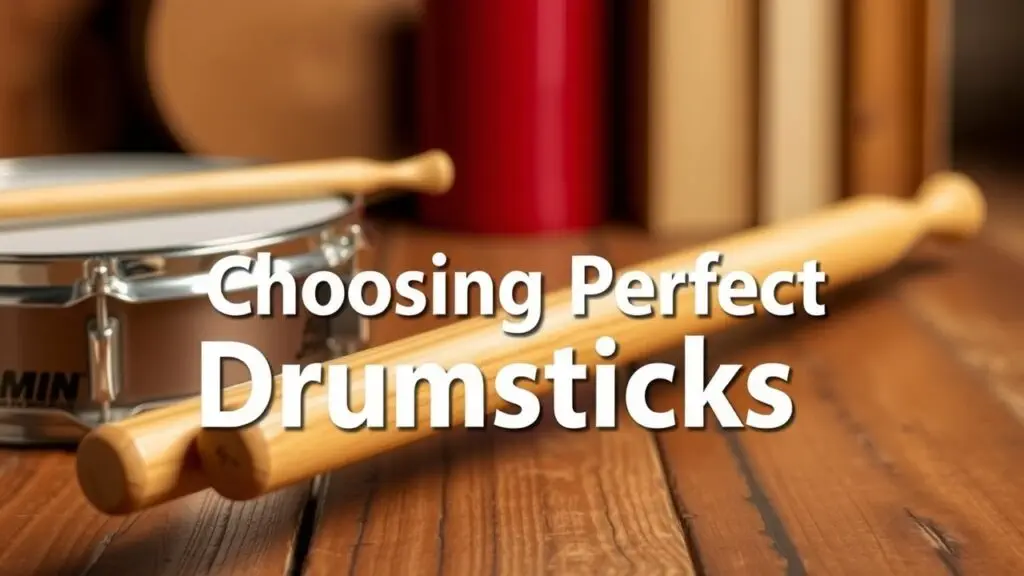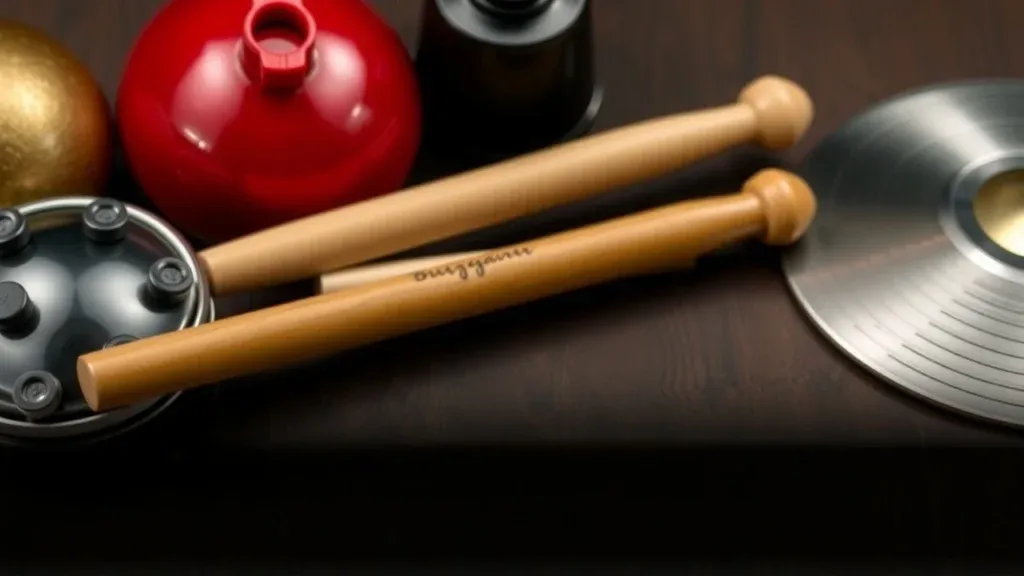Types of drum sticks vary widely; this guide covers different wood types like hickory and maple, along with various sizes and materials to help you find the perfect fit. Understanding drumstick materials and dimensions is key to your drumming style and sound.
What are drumsticks?

Drumsticks are tools that drummers use to hit drums and cymbals. They are super important because they can change how a drummer sounds. There are many types of drum sticks, each made for different styles and needs.
Types of Drum Sticks:
- Wood Drum Sticks: Most drummers prefer these. They feel nice and create good sound. Hickory is strong, while maple is lighter and gives a warmer tone.
- Nylon Drum Sticks: These sticks have a nylon tip that makes a bright sound on cymbals. They last longer than wood but might feel different.
- Metal Drum Sticks: Not used often, but they can make cool sounds. However, they may not work for every music style.
- Plastic Drum Sticks: These are light and great for practice pads or electronic kits, but they don’t sound as good as wood.
Picking the best drumsticks matters because it affects your performance as a drummer. The right sticks help with technique and musical expression.
Why the right stick matters?
Choosing the right drumsticks can change your playing experience in big ways:
- Sound Quality: Different materials create different tones when you hit drums or cymbals.
- Playing Feel: The weight of a stick can make it feel different in your hands. Lighter sticks allow for quicker movements, while heavier sticks can add power.
- Technique Development: Using the right sticks helps you learn good techniques without hurting yourself.
- Injury Prevention: Well-balanced sticks help reduce tiredness during long practices, lowering your chances of injuries like tendonitis.
When you think about how to choose drumsticks, consider your style—whether you’re into rock beats or jazz grooves—and pick based on size (length), weight (light vs heavy), material (wood vs nylon), and how they feel in your grip.
Wood Types: The Heart of Your Drumstick
When you’re picking drumsticks, the wood they’re made from is super important. Different wood types can change how the sticks feel and sound. Here’s a quick look at popular woods for drumsticks and what makes each one unique.
Hickory
Hickory sticks are tough and strong. They can handle lots of use without breaking easily. This wood has great shock absorption, which means it feels good when you play hard. Many pro drummers use American hickory because it lasts long.
Maple
Maple drumsticks are lighter than hickory, which is awesome for speed. They produce a bright sound that fits well in jazz and pop music. If you’re just starting out, the Vic Firth Maple Series is a good pick to help you learn without getting tired too fast.
Oak
Oak drumsticks are dense and provide a powerful sound. They work great for rock and metal music where strong hits matter. But keep in mind, oak sticks are heavier, which may slow you down if you need quick movements. They last long but might not be the best choice for softer music styles.
Other Woods (Birch, Beech)
Birch and beech are less common but still worth mentioning. Birch offers a nice balance between weight and strength, making it versatile across different styles. Beech has similar qualities but can offer slightly different sounds depending on how it’s made.
| Wood Type | Weight | Sound Characteristics | Best Genres |
|---|---|---|---|
| Hickory | Medium | Warm & full | All styles |
| Maple | Light | Bright & crisp | Jazz/Pop |
| Oak | Heavy | Powerful | Rock/Metal |
| Birch | Medium-Light | Balanced | Versatile |
Comparative Analysis of Wood Types
When comparing hickory, maple, and oak:
- Hickory is the all-around champ for durability.
- Maple shines in lighter plays where speed counts.
- Oak gives power but can be limiting if you want flexibility.
Knowing how these woods differ helps you choose the right sticks for your style.
Choosing the Right Wood Type Based on Genre
Picking the right wood type can really boost your playing:
- If you love rock and want volume, go for oak.
- For jazz or pop vibes, maple is your best bet.
- If you’re looking for something versatile across many genres, stick with hickory.
Understanding how wood affects sound helps you pick sticks that fit your musical needs perfectly!
Exploring Synthetic Materials: Beyond Wood
Nylon
Nylon drum sticks are a favorite among drummers. They are tough and last longer than wooden sticks. The sound from nylon tips is often brighter, making cymbals stand out more. This is great for genres like rock and pop, where clarity matters.
Nylon sticks weigh about the same as wooden ones but resist wear better. They don’t splinter or break easily. This makes them a good choice for beginners and intermediate players looking for durable drumsticks.
Plastic
Plastic drum sticks are a cheaper option compared to wood. While they may not give the warm sound of wood, plastic sticks are very durable and cost-effective. They’re light, which helps drummers play fast without getting tired.
The sound from plastic is sharper than wood, which can be good for electronic music where precision is important. Beginners and those on a budget find plastic drumsticks to be a solid choice that doesn’t sacrifice too much quality.
Metal Alloys
Metal alloy drumsticks are used for specific types of music or instruments, like marching bands or heavy metal. Aluminum drumsticks are popular because they are very strong and create a distinct metallic sound that cuts through loud music well.
These sticks tend to be heavier than wood ones, which some drummers like for powerful playing styles. However, their unique sound might not fit every genre perfectly.
Comparison of Synthetic vs. Wood Drum Sticks
Let’s look at how synthetic materials stack up against traditional wood sticks:
| Feature | Synthetic Drum Sticks | Wooden Drum Sticks |
|---|---|---|
| Durability | High | Moderate |
| Sound Quality | Bright/Sharp | Warm/Round |
| Weight Options | Varied | Varied |
| Cost | Generally lower | Varies widely |
Overall, synthetic sticks offer greater durability at lower costs but may lack the rich tone of high-quality woods like hickory or maple that many pros love.
Usage Scenarios for Synthetic Drum Sticks
When should you pick synthetic over wooden options? Here are some tips:
- Best Uses for Nylon Sticks: Great for live shows where you want bright sounds.
- Where to Use Metal Alloy Drums: Ideal for outdoor gigs that need strong gear.
- Choosing Between Wood and Plastic: New drummers might like plastic because it’s affordable; experienced players may prefer wood for feel during complex beats.
Understanding these situations helps you choose the right type based on your needs instead of just going by material.
Care and Maintenance Tips for Synthetic Drum Sticks
To make your non-wooden drumsticks last longer:
- Store them in a cool place away from heat.
- Clean them after use with a damp cloth to remove sweat and oils.
- Check them regularly; even tough materials can wear out if mistreated.
Following these easy steps will keep your synthetic drums performing well through many practices!
Drum Stick Tip Shapes: Sculpting Your Sound
Round Tip
Round tip drum sticks are super flexible. They work for many music styles, which is great! This shape gives a balanced sound. You can play soft or loud, and they still sound good. Many beginners like round tip sticks because they’re easy to use and fit into different styles.
Teardrop Tip
Teardrop tip drum sticks are all about balance. They help you control the sound well. This shape is great for both clear notes and strong hits. If you’re into rock or funk, you’ll love these sticks. But they also work in jazz when you need to be subtle.
Oval Tip
Oval tipped sticks are perfect for creating a refined sound. Jazz musicians often use them since they help with softer music too. The oval shape gives more surface area, leading to richer tones. Drummers who like playing detailed rhythms usually pick oval tips because they let you express yourself better while keeping the volume in check.
Barrel Tip
Barrel tip drumsticks stand out because of their unique sound quality. Their thicker shape makes a strong hit on drums while letting you control techniques like rim shots or ghost notes well. Many drummers appreciate barrel tips for their clarity, even at lower volumes, making them versatile in different music genres.
Acorn Tip
Acorn tipped sticks have a rounded top that looks like an acorn cap. This shape gives bright sounds with good projection but still works well for light playing too. Musicians looking for specific sounds in rock or pop often choose acorn tips due to their crisp attack compared to other shapes.
Choosing The Right Tip Shape
When picking the right tip shape, think about your playing style and what kind of music you enjoy. Here’s a quick guide:
- Rock: Round or barrel tips can give powerful strikes.
- Jazz: Oval or teardrop tips enhance nuance and subtlety.
Knowing how each type affects your playing can help you find the best fit for your needs as a drummer.
Dimensions Matter: Length, Diameter, and Weight
Understanding the dimensions of drumsticks is super important for drummers. The size and weight of your sticks can really change how you play, how comfortable you feel, and even the sound you make. Let’s break down how length, diameter, and weight affect drumming.
Length: Impact on Reach, Power, and Playing Style
Drumstick lengths usually go from about 14 to 17 inches. Short drumsticks, like those around 14 inches, give you better control. They’re often the choice for jazz drummers who need precision. They help with quick moves around the kit but may not hit as hard.
On the flip side, longer drumsticks (up to 17 inches) provide more reach and power. Drummers in rock or metal use them to create strong beats. Longer sticks can hit harder without using too much effort. But for beginners or those used to shorter sticks, they might feel a bit awkward.
Diameter: Effect on Feel, Sound, and Control
The thickness of drumsticks varies a lot; thinner ones are usually .5 to .6 inches wide while thicker ones can be over .7 inches in diameter. Thin drumsticks feel lighter and let you play faster. However, they might create a sharper sound that isn’t as rich.
Thicker drumsticks have more weight. This extra mass helps produce deeper tones when hitting drums or cymbals. Yet, they need more strength to control well—making them a good fit for harder styles like rock or metal.
- Thin Sticks: .5 – .6 inches; Best for Jazz & Light Playing
- Medium Sticks: ~ .6 – .7 inches; Good for Various Styles
- Thick Sticks: > .7 inches; Great for Rock & Metal
Weight: Influence on Playing Comfort, Power, and Speed
Weight matters a lot in how comfortable you are while playing drums and how powerful each hit feels. Drumsticks come in light (around 0.4 ounces), medium (about 0.5 ounces), and heavy weights (over 0.6 ounces).
Lightweight sticks help with speed; they’re perfect for fast music like jazz fusion where you need quick strokes without tiring out easily.
Medium-weight sticks balance speed and power well. They work great across many genres like pop or funk.
Heavyweight sticks are awesome for creating loud sounds with less effort—ideal for heavy styles like rock or metal—but they might tire your arms if used too much without good technique.
Relationship Between Size/Weight and Playing Styles
Picking the right type of drumstick depends mostly on what music you’re playing:
- Best Drum Sticks for Rock: Heavy thick sticks give powerful beats.
- Best Drum Sticks for Jazz: Lightweight thin sticks improve agility.
- Choosing the Right Drums: Think about what feels comfy and what fits your genre when picking sizes that match your needs best.
Knowing these dimensions will help you find the best drumsticks that fit your unique playing style!
Choosing Your Perfect Drumsticks: A Step-by-Step Guide

Playing Style
When picking drum sticks, your playing style is key. Different music styles need different types of drum sticks to get the sound you want. For beginners, it’s best to use lighter sticks. They help with control and reduce tiredness.
If you play rock, you’ll want thicker and heavier sticks. These can give you strong hits on the drums. For jazz, go for thinner and lighter sticks. They allow for more subtle sounds and complex rhythms without overpowering other musicians. Metal drummers often need very durable sticks because they play aggressively. These sticks might be made of hard wood or have nylon tips for extra strength.
Choosing the right stick based on your genre can really improve your performance.
Skill Level
Your skill level matters when learning how to choose drumsticks. Beginners should use lightweight sticks to help them learn techniques without straining their muscles too much. Once you get better, try out different types of drumsticks to find what feels most comfortable and still challenges you.
Advanced players often look for special sticks that suit their playing style or music genre. This might include brushes for softer sounds or mallets for unique tones when playing percussion instruments like timpani.
Knowing about different types of drumsticks helps you make smart choices as your skills grow.
Physical Factors
Physical factors such as hand size and strength can affect how comfortable your drumsticks feel in your hands. If you have smaller hands, shorter or thinner sticks may fit better, improving control while playing.
If you’re stronger or have larger hands, thicker models might give you better leverage when striking the drums hard without losing accuracy over time—this way, you can practice longer while building muscle memory effectively!
Finding the right size of stick ensures you’ll enjoy playing more and practice longer.
Drum Size and Setup
The size of your drums has a big impact on which sticks you should choose since bigger drums need more power behind each hit compared to smaller ones where precision is key! The wood type also matters; harder woods create brighter sounds while softer woods provide warmer tones because of their material properties!
If you’re using an electronic kit instead of acoustic drums, this could also change what materials are best for you based on the desired sound from different setups available today!
Step-by-step Guide
To make choosing drumsticks easier:
- Figure out your playing style (rock or jazz).
- Think about your skill level (beginner or advanced).
- Look at physical factors (hand size & strength).
- Check drum size/setup (acoustic vs electronic).
Following this step-by-step guide makes it simpler to find the perfect pair of drumsticks just right for your needs!
Drumstick Care and Maintenance: Extending the Life of Your Sticks
Proper Grip Techniques
Using the right grip is key for playing and keeping your drumsticks longer. A loose but firm grip helps avoid extra wear. Hold your drumsticks between your thumb and index finger. Let them rest gently on your middle finger. This way gives you control without putting too much pressure, which can cause damage.
Cleaning and Storage Tips
To keep your sticks in great shape, follow these easy steps:
- Wipe Them Down: After each use, grab a soft cloth and wipe off sweat or moisture. This can hurt the wood over time.
- Store Properly: Keep them in a cool, dry spot. Sunlight can make the wood warp or crack.
- Use Protective Cases: A stick bag or case is a smart investment for travel. It keeps them safe from bumps.
Recognizing Signs of Wear
Check your sticks often to see if they need replacing:
- Look for chips or cracks in the wood; these can change how they sound.
- Check if the tips are flat or misshapen. If they look worn out, it’s time for new sticks.
If you see these signs of wear, replace your sticks soon to keep your performance strong.
Additional Considerations
Think about using special products that protect wooden instruments. They help against humidity that could warp or crack wood over time. Also, be careful with how hard you hit when playing—it affects both sound and how long your sticks last.
By following these simple tips on care and maintenance and knowing when to replace your sticks, you’ll always have quality gear to enhance your drumming experience while saving money on replacements.
FAQs about Drum Stick Types
What are the different types of drumsticks available?
Drumsticks come in various types. Common ones include wood sticks, nylon sticks, synthetic options, and metal sticks. Each type serves different musical needs.
How do materials affect drumstick performance?
The material changes sound and feel. Wood offers warmth, while nylon provides bright tones. Synthetic materials offer durability but might lack warmth.
What sizes do drumsticks come in?
Drumsticks vary in size. They can be short, medium, or long. Size affects reach and power.
What weight options are available for drumsticks?
Drumsticks come in lightweight, medium, and heavyweight categories. Lighter sticks enhance speed; heavier ones provide power.
How do I choose the right drumsticks for my style?
To choose the right sticks, consider your music genre. Rock often needs heavier sticks. Jazz benefits from lighter options.
How should I store my drumsticks?
Store your sticks in a cool place away from sunlight. Use stick bags or cases for protection during travel.
How do I maintain my drumsticks?
Clean your sticks after each use with a soft cloth. Check them for wear regularly and replace them if damaged.
Additional Drumstick Insights
- Drumstick Selection Guide: Focus on material, weight, and length.
- Drumstick Comparison Chart: Compare wood vs synthetic options.
- Wood Types for Drumsticks: Explore American hickory and hard maple.
- Short vs Long Drumsticks: Short ones aid control; long ones boost reach.
- Thin vs Thick Drumsticks: Thin sticks suit light playing; thick sticks add power.
- Drumming Accessories: Consider mallets, brushes, practice pads for versatility.
- Stick Bags and Cases: Essential for storage and transport protection.
- Drumstick Resilience: Assess durability based on material choice.
- Drumstick Techniques: Learn proper grip and hitting techniques for better sound.
Related Topics
- types of wood for drumsticks
- types of drum stick materials
- types of drum stick grips
- types of drum stick brands
- types of drum stick sizes
- types of drum stick weights



Types of Drum Sticks: A Complete Guide to Wood, Material, & Size